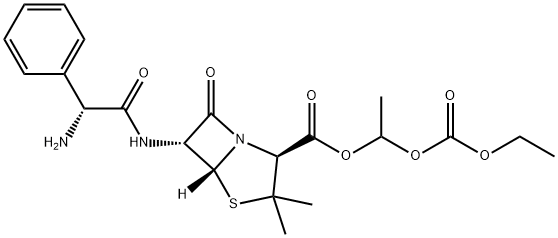Originator
Penglobe,Astra,W. Germany,1977
Definition
ChEBI: A penicillanic acid ester that is the 1-ethoxycarbonyloxyethyl ester of ampicillin. It is a semi-synthetic, microbiologically inactive prodrug of ampicillin.
Manufacturing Process
1'-Ethoxycarbonyloxyethyl 6-(D-α-azidophenylacetamido)penicillinate (98 g)
was prepared from sodium 6-(D-α-azidophenylacetamido)penicillinate (397 g,
1 mol), α-chlorodiethylcarbonate (458 g, 3 mols) and sodium bicarbonate
(504 g, 6 mols). The product showed strong IR absorption at 2090 cm-1 and
1780-1750 cm-1 showing the presence of azido group and β-lactam and ester
carbonyls.
It was dissolved in ethyl acetate (700 ml) and hydrogenated at ambient
conditions over a palladium (5%)on carbon catalyst (18 g). The catalyst was
removed by filtration and washed with ethyl acetate. The combined filtrates
were extracted with water at pH 2.5 by addition of dilute hydrochloric acid.
Lyophilization of the aqueous phase gave the hydrochloride of 1'-
ethoxycarbonyloxyethyl 6-(D-α-aminophenylacetarnido)penicillinate (94 g), MP
171°-176°C.
Therapeutic Function
Antibacterial
Metabolism
Although comparatively well absorbed (30–55%), the oral efficacy of ampicillin for systemic infections can be
enhanced significantly through the preparation of pro-drugs. In contrast to ampicillin itself, which is
amphoteric, bacampicillin is a weak base and is very well absorbed in the duodenum (80–98%). Enzymatic
ester hydrolysis in the gut wall liberates carbon dioxide and ethanol, followed by spontaneous loss of
acetaldehyde and production of ampicillin. The acetaldehyde is metabolized oxidatively by alcohol
dehydrogenase to produce acetic acid, which joins the normal metabolic pool.
